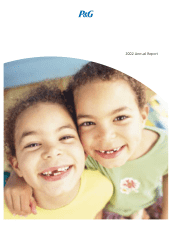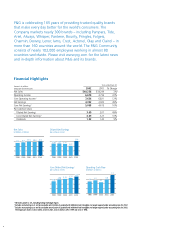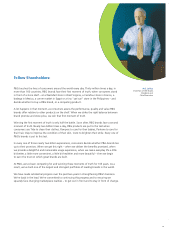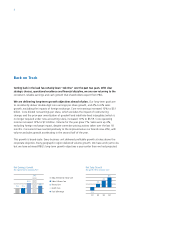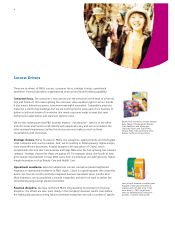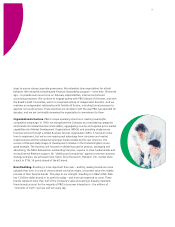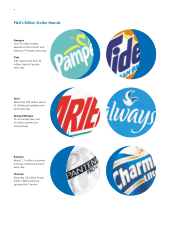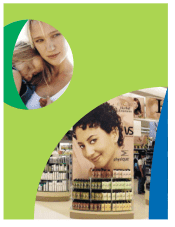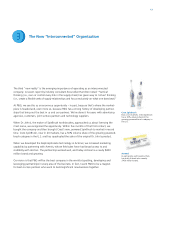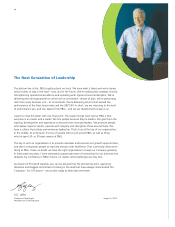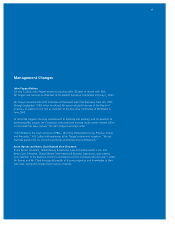Proctor and Gamble 2002 Annual Report Download - page 7
Download and view the complete annual report
Please find page 7 of the 2002 Proctor and Gamble annual report below. You can navigate through the pages in the report by either clicking on the pages listed below, or by using the keyword search tool below to find specific information within the annual report.
steps to ensure strong corporate governance. We reiterated clear expectations for ethical
behavior. We instituted a broad-based Financial Stewardship program – more than 18 months
ago – to provide even more focus on fiduciary responsibilities, internal controls and
accounting processes. We continue to engage openly with P&G's Board of Directors, and
with the Board's Audit Committee, which is comprised entirely of independent directors. And
we maintain an independent relationship with Deloitte & Touche, including formal processes
to approve non-audit services. These practices are consistent with the way P&G has operated
for decades, and we are continually renewing the organization’s commitment to them.
Organizational structure. P&G’s unique operating structure is creating meaningful
competitive advantage. In 1999, we reorganized the Company by consolidating categories
and brands into Global Business Units (GBUs), aggregating country and regional go-to-market
capabilities into Market Development Organizations (MDOs) and providing single-source
business services through a Global Business Services organization (GBS). It has taken some
time to implement, but we’re now reaping real advantage from consumer and market
responsiveness and the substantial synergies made possible by the new structure. The success
of Pampers Baby Stages of Development initiative in the United Kingdom is one good
example. The business unit focused on delivering superior product, packaging and
advertising; the MDO delivered an outstanding trial plan, superior in-store fundamentals and
strong External Relations support. By “dividing and conquering” against a common business
strategy and plan, we achieved more, faster. Since the launch, Pampers’ U.K. market share
is back to 51%, 16 points ahead of the #2 brand.
Brand building. Branding is more important than ever – and big, leading brands are more
valuable than ever. In a sea of choices where confusion reigns, consumers value the reliable
promise of their favorite brands. This plays to our strength: branding is in P&G’s DNA. P&G
has 12 billion-dollar brands in its portfolio today – and more are expected to come. These
brands represent more than half of the Company’s sales and profits. Equally important, these
brands account for the majority of P&G’s consumer interactions – the millions of “moments
of truth” we face and win every day.
5
steps to ensure strong corporate governance. We reiterated clear expectations for ethical
behavior. We instituted a broad-based Financial Stewardship program – more than 18 months
ago – to provide even more focus on fiduciary responsibilities, internal controls and
accounting processes. We continue to engage openly with P&G’s Board of Directors, and with
the Board’s Audit Committee, which is comprised entirely of independent directors. And we
maintain an independent relationship with Deloitte & Touche, including formal processes to
approve non-audit services. These practices are consistent with the way P&G has operated for
decades, and we are continually renewing the organization’s commitment to them.
Organizational structure. P&G’s unique operating structure is creating meaningful
competitive advantage. In 1999, we reorganized the Company by consolidating categories
and brands into Global Business Units (GBUs), aggregating country and regional go-to-market
capabilities into Market Development Organizations (MDOs) and providing single-source
business services through a Global Business Services organization (GBS). It has taken some
time to implement, but we’re now reaping real advantage from consumer and market
responsiveness and the substantial synergies made possible by the new structure. The
success of Pampers Baby Stages of Development initiative in the United Kingdom is one
good example. The business unit focused on delivering superior product, packaging and
advertising; the MDO delivered an outstanding trial plan, superior in-store fundamentals and
strong External Relations support. By “dividing and conquering” against a common business
strategy and plan, we achieved more, faster. Since the launch, Pampers’ U.K. market share
is back to 51%, 16 points ahead of the #2 brand.
Brand building. Branding is more important than ever – and big, leading brands are more
valuable than ever. In a sea of choices where confusion reigns, consumers value the reliable
promise of their favorite brands. This plays to our strength: branding is in P&G’s DNA. P&G
has 12 billion-dollar brands in its portfolio today – and more are expected to come. These
brands represent more than half of the Company’s sales and earnings. Equally important,
these brands account for the majority of P&G’s consumer interactions – the millions of
“moments of truth” we face and win every day.

